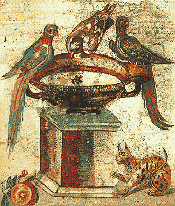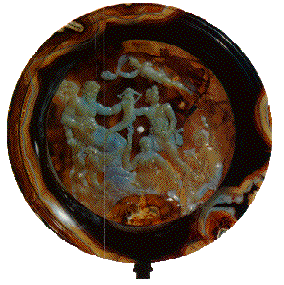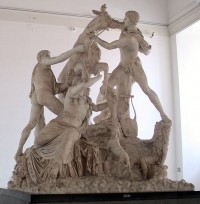The lively city of Naples has a lot to offer, from a 13th-century Gothic cathedral to terrific pizza joints, but the most compelling attraction by far is the National Archeological Museum of Naples – Museo Archeologico Nazionale de Napoli. It is one of the great classical museums of Europe. If you are going to see Pompeii or Herculaneum – and you should – it’s a must.
 The museum holds an astonishing number of treasures from the cities that were destroyed by the eruption of Mt. Vesuvius in 79 C.E. Buried for centuries, preserved by ash and mud, thousands of artifacts are in beautiful (restored) condition. You’ll marvel at the detail in the mosaics of dogs, fish, cats and horses. There are comic and battle-action scenes in mosaics and paintings, delicate murals, tableware, vases, and bronzes. Frescoes from homes and temples show scenes of daily life, mythology, and heroes, many colored with the famous, vivid “Pompeii Red” (Rosso Pompeiano). Lovely glassware is displayed. The Farnese Cup, made from sardonyx agate, dates from 150 BCE and is one of the largest cameos in the world.
The museum holds an astonishing number of treasures from the cities that were destroyed by the eruption of Mt. Vesuvius in 79 C.E. Buried for centuries, preserved by ash and mud, thousands of artifacts are in beautiful (restored) condition. You’ll marvel at the detail in the mosaics of dogs, fish, cats and horses. There are comic and battle-action scenes in mosaics and paintings, delicate murals, tableware, vases, and bronzes. Frescoes from homes and temples show scenes of daily life, mythology, and heroes, many colored with the famous, vivid “Pompeii Red” (Rosso Pompeiano). Lovely glassware is displayed. The Farnese Cup, made from sardonyx agate, dates from 150 BCE and is one of the largest cameos in the world.
 The museum is full of Greek, Roman, Egyptian and Renaissance pieces, many from the Farnese collection. The classical sculpture, mainly Roman copies of earlier Greek works, is important because the originals are long lost. The Farnese Atlas is the oldest existing depiction of the Greek mythological hero, and presumably the earliest view of the constellations. A truly stunning sculpture is The Farnese Bull, considered the largest antique sculpture ever recovered. Remarkably intricate and lifelike, carved from a single piece of marble, it’s a work of genius.
The museum is full of Greek, Roman, Egyptian and Renaissance pieces, many from the Farnese collection. The classical sculpture, mainly Roman copies of earlier Greek works, is important because the originals are long lost. The Farnese Atlas is the oldest existing depiction of the Greek mythological hero, and presumably the earliest view of the constellations. A truly stunning sculpture is The Farnese Bull, considered the largest antique sculpture ever recovered. Remarkably intricate and lifelike, carved from a single piece of marble, it’s a work of genius.
 Look closely at the interwoven figures in The Bull, and you’ll see realistic muscles as two young men strain to hold an enraged bull. Details of the rope cords, the woman’s fear as they bind her to the bull, the beseeching mother’s expression, are all there. The myth represented is horrific, of course – they’re punishing the woman for trying to kill their mother. But the art is magnificent.
Look closely at the interwoven figures in The Bull, and you’ll see realistic muscles as two young men strain to hold an enraged bull. Details of the rope cords, the woman’s fear as they bind her to the bull, the beseeching mother’s expression, are all there. The myth represented is horrific, of course – they’re punishing the woman for trying to kill their mother. But the art is magnificent.
For something more lighthearted, turn to The Faun, another amazing work of art. The Faun holds cymbals and seems to dance on his toes, laughing as he holds a young Bacchus on his shoulders. Then there’s the Secret Room, where every visitor giggles or smirks. There’s no extra charge, but you have to request it and book a time when you buy your entrance ticket. Those Pompeiians were not subtle when it came to erotic art; the exaggerated sexual imagery leaves nothing to the imagination. Can you picture these on a shelf in your living room?
The Archeological Museum, on Piazza Museo, is open daily except for Tuesdays.


Comments